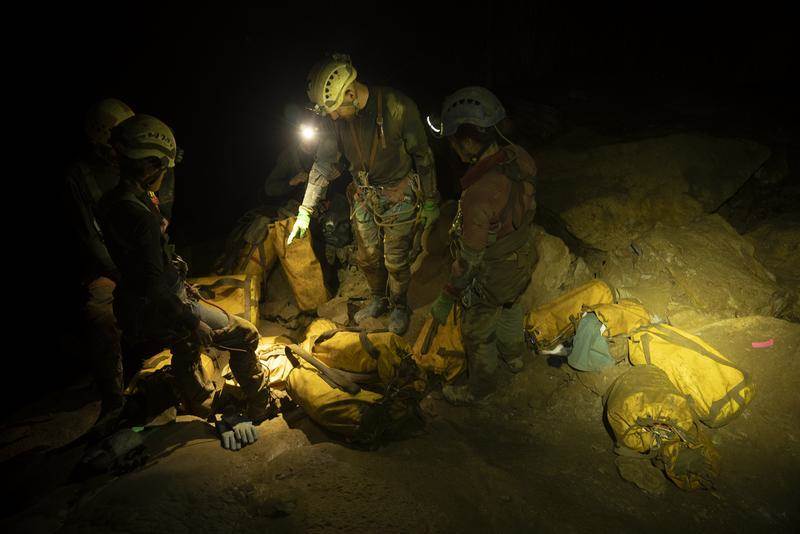“There is no rescue organization in the world that actually could retrieve somebody from the bottom of this cave,” Dr. Bill Stone said of the risks taken to explore Chevé Cave, an adventure that is documented in the National Geographic documentary Explorer: The Deepest Cave. “There’s no fire rescue, no mountain rescue, anything like that,” Bill continued during a TCA press conference about the special, which premieres tonight at 10/9c. “We basically design the team for self-rescue capability from the start, and it’s been one of the tenets of those expeditions for decades now.” In the documentary, viewers will get to see how these safety protocols are implemented.
Chevé Cave in Mexico is believed to be the deepest cave in the world and the documentary chronicles an expedition deeper than any human has ever gone before. “Nothing smells except for our socks, maybe,” director of photography and cave explorer Kasia Biernacka joked about the level of sensory deprivation found in Chevé Cave. “There are no bad smells, good smells, so it’s neutral, smelling neutral. So that first thing that strikes us in our face when we are getting out of the cave is the smell of the pine forest around the entrance. It’s so beautiful. You’re like getting back to real life. You see the leaves, the forest, and the smells.”
Caves are often associated with animals like bats, but this one is unique. “Chevé is a very high elevation, you’re starting at almost 3,000 meters above sea level,” Dr. Bill Sotne explained. “Unlike a lot of tropical caves, you don’t really see what you would call cave life, like bats and things like that, and snakes and other ground critters. There just isn’t a lot of food up there. In fact, there aren’t a whole lot of surface creatures up there either. And as you go down, it becomes less and less, so by the time you get beyond Camp 3 you’re down to an occasional, tiny, millimeter level isopod or some other springtail or things like that. And that’s about it. You really don’t see much. The cave does get warmer. The sinkhole serves as a cold trap and so sometimes, even as deep as Camp 1, which is like 400 meters, it can be down near low 40s or high 30s if there’s a big storm outside. However, as you get down deeper in the cave, it does get warmer. So by the time you reach Camp 3, it’s like around 55 Fahrenheit, around 12 C, something like that. And the wind is one of the big environmental factors there. Everybody who works in this place quickly recognizes that there’s an amazing torrent of wind flowing into this cave. In fact, it’s one of the key symbols that we use to guide the exploration.”
“It was a lot more humid than I expected,” director Pablo Durana revealed. “For camera gear, I think that was one of our biggest challenges is fighting the humidity, so that was part of the environment that I never expected. And like Bill said, I was really amazed at how windy it was. Even like deep down and trying to fly a drone without GPS in the wind creates its own set of challenges. The environment in the cave is pretty spectacular. I’ve never experienced darkness like that, which is calming in a certain way, but also pretty frightful at times.”
“The only thing I can think of that might be close to this would be either being one of the lunar astronauts or being somebody who has been in a war with a small group of people whom they get to know very well and are under stressful conditions,” Dr. Bill Stone said of the experience of descending this deep into a cave with a small group of people. “I could tell you stories about every single one of those people who were out there and they're all over-technically qualified and multi-disciplinarians. You don’t go there if you aren't. But the other thing is simply that these people didn't get there by accident. They are the ones whose smile on their face gets bigger the more remote from humanity they get. These are the kind of people who would be completely, utterly comfortable sitting at the bottom of Shackleton crater on the moon. I have no doubt of that.”
“When you come to the surface, the cave itself, it’s all grays and browns, which is fine, and you sort of don’t notice that lack of color until you come back, geologist and cave explorer Bev Shade concluded about the return to the surface. “The thing that always gets me is the color green. It’s just so wonderful.”
Don’t miss Explorer: The Deepest Cave, premiering Monday, May 30th at 10/9c on National Geographic and coming soon to Disney+.

